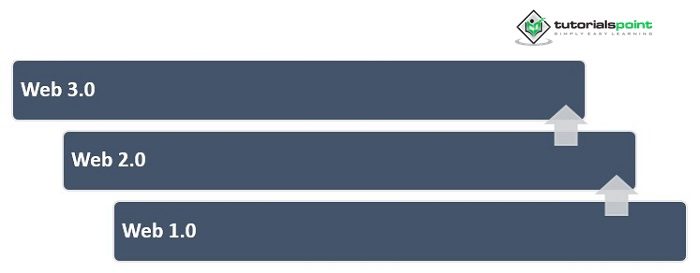
 Data Structure
Data Structure Networking
Networking RDBMS
RDBMS Operating System
Operating System Java
Java MS Excel
MS Excel iOS
iOS HTML
HTML CSS
CSS Android
Android Python
Python C Programming
C Programming C++
C++ C#
C# MongoDB
MongoDB MySQL
MySQL Javascript
Javascript PHP
PHP
- Selected Reading
- UPSC IAS Exams Notes
- Developer's Best Practices
- Questions and Answers
- Effective Resume Writing
- HR Interview Questions
- Computer Glossary
- Who is Who
What is Web 3.0 & how it is different from Web 1.0 & Web 2.0?
In today's world, who does not use internet and one who uses internet must aware of www, a pragmatic interface that made life easy. In the late 1980s, Sir Tim Berners-Lee was working at the European Organization for Nuclear Research in Geneva, Switzerland, when he created the Web, first time (1989). Since that time, the web application has increasingly become an indispensable resource in the field of computer science, as it has started assisting people in their everyday lives in such areas as education, government services, trade and commerce, employment, health care, etc.

What is WWW?
It literally stands for "World Wide Web." In this internet based application, various computer systems are interlinked, and documents and other files are made available in the form of hypertext documents. With the help of a web browser, a user surfs web pages carrying information in the form of text, images, and videos, irrespective of his or her geographical location. Over a period of time, www has experienced growth in stages, such as - Web 1.0, which was the first stage of invention and had basic applications, such as connecting information and making it available through the internet.

The first version of web technology provided only reading Information published on the website. A few years later, Web 2.0 developed. It was one step ahead, as it facilitated an interactive interface that connected people by putting "I" in user interface and the "web" into the web of social participation. And finally, web 3.0 developed, which is infused with artificial intelligence and user-friendly applications. It includes various features and represents meanings, connecting knowledge, and putting it to work in such a way that makes the use of the internet more relevant, useful, and enjoyable.
What is Web 1.0?
Web 1.0 is all about reading and providing your own information. Web 1.0 is primarily used in the first stage of worldwide evolution, in which the majority of users are consumers. Static web pages are the most common way to connect millions of people around the globe. Web 1.0 provides us with the feature for the content delivery network (CDN), which enables the piece of information on the websites. It can be used to provide personal information. The cost for viewing is per page viewed. It has database directories to enable users to retrieve a particular piece of information. The era of Web 1.0 started roughly in 1989 and ended in 2005.
What is Web 2.0?
Web 2.0 is all about interacting with the user, along with reading, writing, and creating to a certain extent on the programmable web. It is a worldwide website that highlights user usability and interoperability for the end user. AJAX and JavaScript have been very popular for creating Web 2.0. The tools that are used in Web 2.0 are blogging, tagging, social networking, podcasting, etc. It started roughly in 1999 and ended in 2012.
What is Web 3.0?
Web 3.0 ? Web 3.0 is the current version for reading, writing, and owning that will be used for the decentralized web. It is used for utilizing the web and interacting with the live data stream. The Semantic Web uses a declarative ontological language like OWL to produce domain-specific ontologies that machines can use to reason about information and draw new conclusions, not simply match keywords.
Difference between Web 1.0, Web 2.0, and Web 3.0.
The following table illustrates the major differences between web 1.0, web 2.0, and web 3.0:
| Web 1.0 | Web 2.0 | Web 3.0 | |
|---|---|---|---|
| 1. | It connects real people to the world wide web (www). | It connects real people who use the World Wide Web (www). | It will connect the virtual representatives of the real people who use the World Wide Web (www). |
| 2. | It is about providing your own information. | It is about the overload or sharing of information. | It is about the consolidated control of information. |
| 3. | Web 1.0 is generally referred to as the "read-only web" or "visual/interactive web," making content available online for viewing. | Users can read, write, and collaborate on the Programmable Web to a certain extent. | Web-linked information can be read, written, and executed by users. |
| 4. | Internet users are restricted to reading content from the web.Examples: email, P2P file sharing, content, file or web servers, search engines, and business portals. | It enhances the interactivity of the user's Web service endpoint with an add-on published feature. Examples are Instant messaging, Ajax and JavaScript frameworks, and Adobe Flex. | It further enhances by adding data-space semantics markup and a web service to execute. Examples Personal intelligent data assistants, ontologies, knowledge bases, and semantic search functions |
| 5. | Examples of the web era include the millions of homepages with static websites and DOT COM bubbles. | Examples are Twitter, Flickr, Facebook, and YouTube for creating wikis and blogs. | Examples are deductive reasoning, tailor-made searches, an evaluation of the 3D web for waves, and live streams. |
| 6. | Web 1.0 is commonly used in HTML, HTTP, URLs, and portals. | Web 2.0 is commonly used in XML and RSS. | Web 2.0 is commonly used in RDF, RDFS, and OWL. |
| 7. | It is mainly focused on the company. | It is mainly focused on the community. | It is mainly focused on the individual. |
| 8. | It started in 1989-2005. | It started in 1999-2012. | It is ongoing and started in 2006. |
| 9. | It is like a banner advertisement. | It is interactive advertising. | It is behavioural advertising. |
| 10. | Web 1.0 is used in Encyclopedia Britannica online. | Web 2.0 is used in Wikipedia. | Web 3.0 is used in the semantic web. |
Conclusion
The future of the Web and the internet is Web 3.0. With the development of technology, the Web is also evolving from Web 1.0 to Web 2.0 and then to Web 3.0. Web 3.0 technologies in decision support systems will also be discussed, along with some anticipated Web 3.0 application domains. We will manage, search, and handle personal demand in Web 3.0. Beginning with the connection of information, web technologies next go on to the connection of people. But because of the integration of many technologies that provide a logical connection across networks, the new web is able to comprehend, interpret, and manage information. Web 2.0 technologies, a semantic web, and artificial intelligence are all necessary for future Web 3.0 technology.

